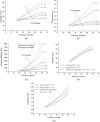Plasticity and Enzymatic Degradation Coupled With Volumetric Growth in Pulmonary Hypertension Progression
- PMID: 34076235
- PMCID: PMC8299811
- DOI: 10.1115/1.4051383
Plasticity and Enzymatic Degradation Coupled With Volumetric Growth in Pulmonary Hypertension Progression
Abstract
Pulmonary hypertension (PH) is one of the least understood and highly elusive cardiovascular conditions associated with elevated pulmonary arterial pressure. Although the disease mechanisms are not completely understood, evidence has accumulated from human and animal studies that irreversible processes of pulmonary arterial wall damage, compensated by stress-mediated growth, play critical roles in eliciting the mechanisms of disease progression. The aim of this study is to develop a thermodynamic modeling structure of the pulmonary artery to consider coupled plastic-degradation-growth irreversible processes to investigate the mechanical roles of the dissipative phenomena in the disease progression. The proposed model performs a model parameter study of plastic deformation and degradation processes coupled with dissipative growth subjected to elevated pulmonary arterial pressure and computationally generates in silico simulations of PH progression using the clinical features of PH, found in human morphological and mechanical data. The results show that considering plastic deformation can provide a much better fitting of the ex vivo inflation tests than a widely used pure hyperelastic model in higher pressure conditions. In addition, the parameter sensitivity study illustrates that arterial damage and growth cause the increased stiffness, and the full simulation (combining elastic-plastic-degradation-growth models) reveals a key postpathological recovery process of compensating vessel damage by vascular adaptation by reducing the rate of vessel dilation and mediating vascular wall stress. Finally, the simulation results of luminal enlargement, arterial thickening, and arterial stiffness for an anisotropic growth are found to be close to the values from the literature.
Keywords: arterial damage; disease progression; parametric sensitive analysis; pulmonary hypertension; thermodynamic modeling.
Copyright © 2021 by ASME.
Figures









Similar articles
-
Multi-scaled temporal modeling of cardiovascular disease progression: An illustration of proximal arteries in pulmonary hypertension.J Biomech. 2024 May;168:112059. doi: 10.1016/j.jbiomech.2024.112059. Epub 2024 Mar 24. J Biomech. 2024. PMID: 38631187 Free PMC article.
-
Linked opening angle and histological and mechanical aspects of the proximal pulmonary arteries of healthy and pulmonary hypertensive rats and calves.Am J Physiol Heart Circ Physiol. 2011 Nov;301(5):H1810-8. doi: 10.1152/ajpheart.00025.2011. Epub 2011 Aug 19. Am J Physiol Heart Circ Physiol. 2011. PMID: 21856906 Free PMC article.
-
Cardiovascular mechanics in the early stages of pulmonary hypertension: a computational study.Biomech Model Mechanobiol. 2017 Dec;16(6):2093-2112. doi: 10.1007/s10237-017-0940-4. Epub 2017 Jul 21. Biomech Model Mechanobiol. 2017. PMID: 28733923
-
Pathobiology of pulmonary arterial hypertension: understanding the roads less travelled.Eur Respir Rev. 2017 Dec 20;26(146):170093. doi: 10.1183/16000617.0093-2017. Print 2017 Dec 31. Eur Respir Rev. 2017. PMID: 29263173 Free PMC article. Review.
-
Pathophysiology and clinical implications of pulmonary arterial enlargement in COPD.Int J Chron Obstruct Pulmon Dis. 2013;8:509-21. doi: 10.2147/COPD.S52204. Epub 2013 Oct 29. Int J Chron Obstruct Pulmon Dis. 2013. PMID: 24235822 Free PMC article. Review.
Cited by
-
Computational modelling of multi-temporal ventricular-vascular interactions during the progression of pulmonary arterial hypertension.J R Soc Interface. 2022 Nov;19(196):20220534. doi: 10.1098/rsif.2022.0534. Epub 2022 Nov 23. J R Soc Interface. 2022. PMID: 36415977 Free PMC article.
-
Enhancing decellularized vascular scaffolds with PVDF and PCL reinforcement: a fused deposition modeling approach.Front Cardiovasc Med. 2023 Nov 29;10:1257812. doi: 10.3389/fcvm.2023.1257812. eCollection 2023. Front Cardiovasc Med. 2023. PMID: 38094125 Free PMC article.
-
Multi-scaled temporal modeling of cardiovascular disease progression: An illustration of proximal arteries in pulmonary hypertension.J Biomech. 2024 May;168:112059. doi: 10.1016/j.jbiomech.2024.112059. Epub 2024 Mar 24. J Biomech. 2024. PMID: 38631187 Free PMC article.
References
-
- Rajagopal, S. , Forsha, D. E. , Risum, N. , Hornik, C. P. , Poms, A. D. , Fortin, T. A. , Tapson, V. F. , Velazquez, E. J. , Kisslo, J. , and Samad, Z. , 2014, “ Comprehensive Assessment of Right Ventricular Function in Patients With Pulmonary Hypertension With Global Longitudinal Peak Systolic Strain Derived From Multiple Right Ventricular Views,” J. Am. Soc. Echocardiogr., 27(6), pp. 657–665..10.1016/j.echo.2014.02.001 - DOI - PubMed
-
- Todorovich-Hunter, L. , Dodo, H. , Ye, C. , McCready, L. , Keeley, F. W. , and Rabinovitch, M. , 1992, “ Increased Pulmonary Artery Elastolytic Activity in Adult Rats With Monocrotaline-Induced Progressive Hypertensive Pulmonary Vascular Disease Compared With Infant Rats With Nonprogressive Disease,” Am. Rev. Respir. Disease, 146(1), pp. 213–223.10.1164/ajrccm/146.1.213 - DOI - PubMed
Publication types
MeSH terms
Grants and funding
LinkOut - more resources
Full Text Sources
Medical

